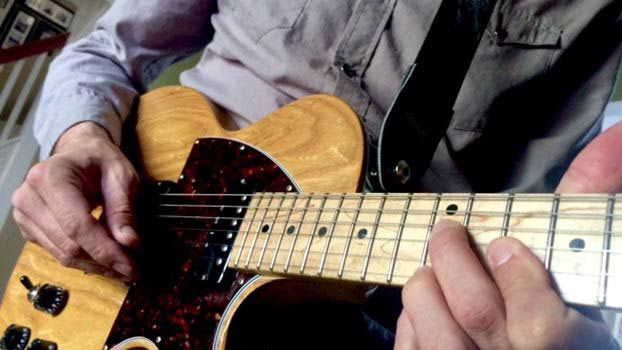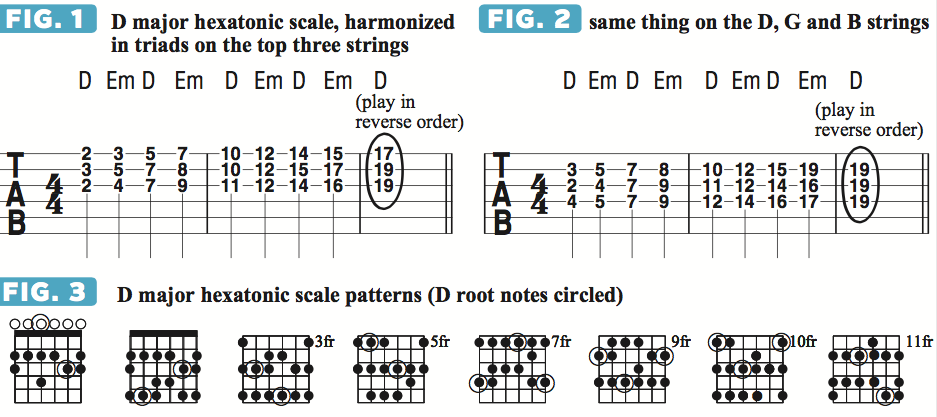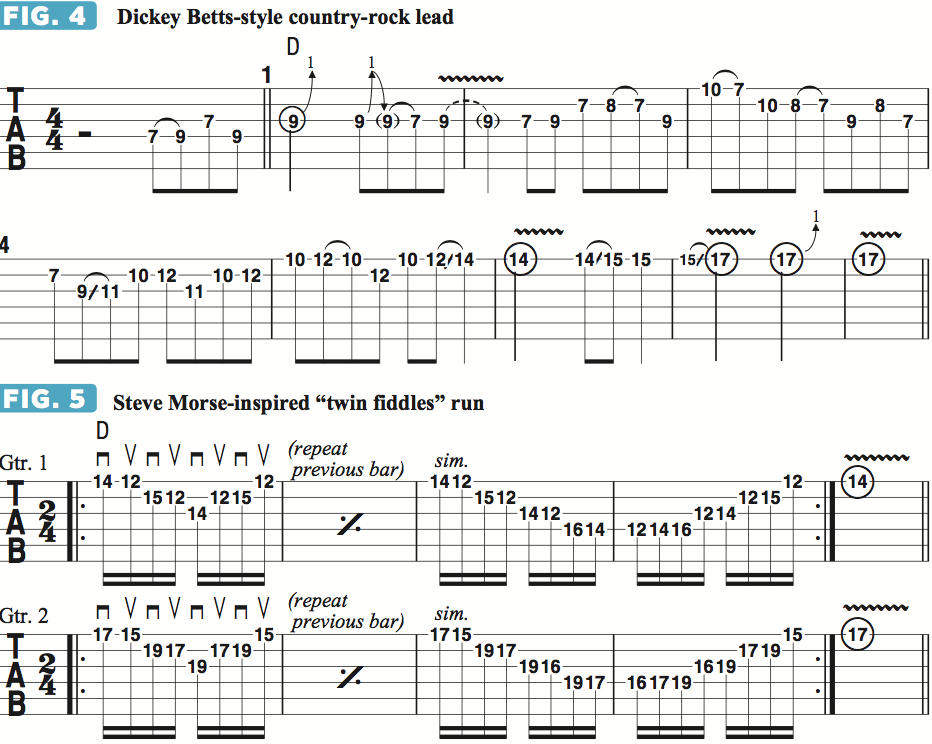The E Minor/D Major-Hexatonic Connection
Get a primer on this appealing and useful hexatonic scale.

Last month I presented the six-note E minor hexatonic scale (E F# G A B D), which has a dark, serious quality that’s ideal for creating a pensive, reflective mood.
I’d now like to turn you on to another, equally appealing and useful hexatonic scale (depending on your musical tastes), one that is comprised of the very same notes, which would qualify it as a mode, but sounds completely different—beautifully bright and joyous—and that is D major hexatonic (D E F# G A B).
As I explained last month, E minor hexatonic is formed by taking E minor pentatonic (E G A B D) and adding one note, the second, F#, resulting in the intervallic spelling 1 2 b3 4 5 b7.
It may also be analyzed as the combination of E minor (E G B) and D major (D F# A) triads. D major hexatonic is formed by combining these same two triads, but in this case oriented around a D root note. The two scales may be thought of as opposite sides of the same musical coin, or, as the Chinese say, yin and yang.
To illustrate, FIGURE 1 shows E minor and D major triad inversions “leapfrogging” each other up the neck on the top three strings, just like FIGURE 1 from last month’s lesson, only now we’re starting and ending on D instead of Em. (To get the sound of the D root note in your head, pick your open D string before strumming the chords.)
To hear the scale played as single notes, play only those on the B string, then try adding finger slides and vibrato and pairing any two of the three strings to create some “down-home,” heart-warming, gospel-flavored harmonies. As an additional resource, FIGURE 2 shows D and Em triads passing each other up the neck on the D, G and B strings.
Here’s another way to think of D major hexatonic: take D major pentatonic (D E F# A B) and add G, the fourth, or take the D major scale (D E F# G A B Cs) and omit the seventh, C#. The resulting scale formula is 1 2 3 4 5 6. FIGURE 3 illustrates a set of two-octave fingering patterns for D major hexatonic played across all six strings in a variety of positions, all of which are based on the D major pentatonic “box” shapes, with a G note added in every octave. As with last month’s E minor hexatonic shapes, you’ll no doubt find that the compact ones that don’t require any wide stretches or rely much on the pinkie are the most comfortable and useful, or that just a portion of a particular shape works well across a smaller group of strings.
FIGURE 4 is a country-rock-flavored solo phrase inspired by Allman Brothers Band founding guitarist Dickey Betts, who, with his signature lyrical phrasing style—characterized by rolling eighth notes and use of hammer-ons, pull-offs, finger slides and precision bends—pretty much owns major hexatonic. For great examples of Betts soloing with this scale in a variety of keys, check out “Jessica,” “Blue Sky,” “Melissa,” “Ramblin’ Man” and “Where It All Begins.”
FIGURE 5 is an alternate-picked, bluegrass-style “twin-fiddles” run inspired by Steve Morse and his legendary band the Dixie Dregs, particularly their uptempo “barn burner,” “The Bash.” Here we have two lead guitars harmonizing D major hexatonic in thirds and fourths as these intervals naturally occur within the scale.


Get The Pick Newsletter
All the latest guitar news, interviews, lessons, reviews, deals and more, direct to your inbox!
Over the past 30 years, Jimmy Brown has built a reputation as one of the world's finest music educators, through his work as a transcriber and Senior Music Editor for Guitar World magazine and Lessons Editor for its sister publication, Guitar Player. In addition to these roles, Jimmy is also a busy working musician, performing regularly in the greater New York City area. Jimmy earned a Bachelor of Music degree in Jazz Studies and Performance and Music Management from William Paterson University in 1989. He is also an experienced private guitar teacher and an accomplished writer.
“There are so many sounds to be discovered when you get away from using a pick”: Jared James Nichols shows you how to add “snap, crackle and pop” to your playing with banjo rolls and string snaps
Don't let chord inversions bamboozle you. It's simply the case of shuffling the notes around








![Joe Bonamassa [left] wears a deep blue suit and polka-dotted shirt and plays his green refin Strat; the late Irish blues legend Rory Gallagher [right] screams and inflicts some punishment on his heavily worn number one Stratocaster.](https://cdn.mos.cms.futurecdn.net/cw28h7UBcTVfTLs7p7eiLe.jpg)


